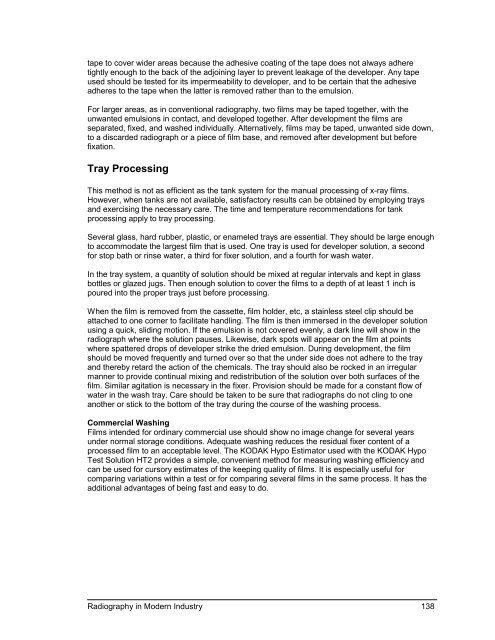Radiography in Modern Industry - Kodak
Radiography in Modern Industry - Kodak
Radiography in Modern Industry - Kodak
Create successful ePaper yourself
Turn your PDF publications into a flip-book with our unique Google optimized e-Paper software.
tape to cover wider areas because the adhesive coat<strong>in</strong>g of the tape does not always adheretightly enough to the back of the adjo<strong>in</strong><strong>in</strong>g layer to prevent leakage of the developer. Any tapeused should be tested for its impermeability to developer, and to be certa<strong>in</strong> that the adhesiveadheres to the tape when the latter is removed rather than to the emulsion.For larger areas, as <strong>in</strong> conventional radiography, two films may be taped together, with theunwanted emulsions <strong>in</strong> contact, and developed together. After development the films areseparated, fixed, and washed <strong>in</strong>dividually. Alternatively, films may be taped, unwanted side down,to a discarded radiograph or a piece of film base, and removed after development but beforefixation.Tray Process<strong>in</strong>gThis method is not as efficient as the tank system for the manual process<strong>in</strong>g of x-ray films.However, when tanks are not available, satisfactory results can be obta<strong>in</strong>ed by employ<strong>in</strong>g traysand exercis<strong>in</strong>g the necessary care. The time and temperature recommendations for tankprocess<strong>in</strong>g apply to tray process<strong>in</strong>g.Several glass, hard rubber, plastic, or enameled trays are essential. They should be large enoughto accommodate the largest film that is used. One tray is used for developer solution, a secondfor stop bath or r<strong>in</strong>se water, a third for fixer solution, and a fourth for wash water.In the tray system, a quantity of solution should be mixed at regular <strong>in</strong>tervals and kept <strong>in</strong> glassbottles or glazed jugs. Then enough solution to cover the films to a depth of at least 1 <strong>in</strong>ch ispoured <strong>in</strong>to the proper trays just before process<strong>in</strong>g.When the film is removed from the cassette, film holder, etc, a sta<strong>in</strong>less steel clip should beattached to one corner to facilitate handl<strong>in</strong>g. The film is then immersed <strong>in</strong> the developer solutionus<strong>in</strong>g a quick, slid<strong>in</strong>g motion. If the emulsion is not covered evenly, a dark l<strong>in</strong>e will show <strong>in</strong> theradiograph where the solution pauses. Likewise, dark spots will appear on the film at po<strong>in</strong>tswhere spattered drops of developer strike the dried emulsion. Dur<strong>in</strong>g development, the filmshould be moved frequently and turned over so that the under side does not adhere to the trayand thereby retard the action of the chemicals. The tray should also be rocked <strong>in</strong> an irregularmanner to provide cont<strong>in</strong>ual mix<strong>in</strong>g and redistribution of the solution over both surfaces of thefilm. Similar agitation is necessary <strong>in</strong> the fixer. Provision should be made for a constant flow ofwater <strong>in</strong> the wash tray. Care should be taken to be sure that radiographs do not cl<strong>in</strong>g to oneanother or stick to the bottom of the tray dur<strong>in</strong>g the course of the wash<strong>in</strong>g process.Commercial Wash<strong>in</strong>gFilms <strong>in</strong>tended for ord<strong>in</strong>ary commercial use should show no image change for several yearsunder normal storage conditions. Adequate wash<strong>in</strong>g reduces the residual fixer content of aprocessed film to an acceptable level. The KODAK Hypo Estimator used with the KODAK HypoTest Solution HT2 provides a simple, convenient method for measur<strong>in</strong>g wash<strong>in</strong>g efficiency andcan be used for cursory estimates of the keep<strong>in</strong>g quality of films. It is especially useful forcompar<strong>in</strong>g variations with<strong>in</strong> a test or for compar<strong>in</strong>g several films <strong>in</strong> the same process. It has theadditional advantages of be<strong>in</strong>g fast and easy to do.<strong>Radiography</strong> <strong>in</strong> <strong>Modern</strong> <strong>Industry</strong> 138
















